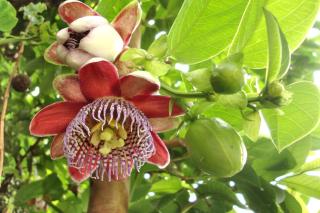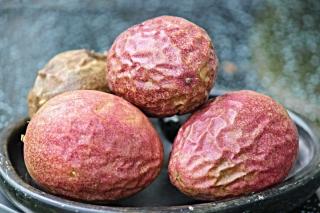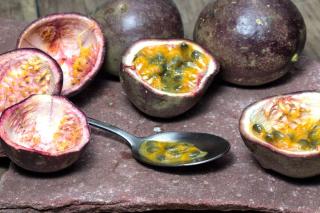

Maracuya or passion fruit is known for its many health benefits and high therapeutic value. It belongs to the Passifloraceae or passion flower family. It is the fruit of a climbing vine called Passion flower, or Passiflora edulis.
Passion fruits come in different colors: violet, yellow, green and many more. This fruit, just like its parent plant, offers many health benefits.
It can be eaten all year round.

Did you know? The passion fruit flower “represents” the Passion of Christ. Its features are like as many symbols of the crown of thorns, hammer and nails, the apostles… That is where the name “passion fruit” comes from.
Passion fruits benefit us in many ways.
This fruit is a source of powerful antioxidants that neutralize free radicals. Free radicals are responsible for damaging our cells, leading to cancers and other diseases. Passion fruits protect us from cardiovascular diseases since they reduce our bad cholesterol levels.
Very high vitamin C levels (30 mg / 3.5 oz (100 g)) in passion fruit flesh help boost immunity. Vitamin C is also famous for staving off cell aging and accelerates wound healing. Other vitamins are also found such as vitamin A which enhances vision and several vitamins from the B group.
Passion fruit is very easy to digest with its high fiber content. It helps digestion and improves intestinal transit.

Passion fruit is also prescribed in case of tiredness or of sleeping disorders. Its anti-inflammatory properties would reduce the severity of asthma symptoms and free respiratory tracts.
American Indians used the juice pressed from the fruit to alleviate sore eyes.
Caloric intake when eating this fruit is reasonable, and this contributes to any healthy diet.
Skin wounds and burns are soothed when passion fruit pulp is lathered on. Very nice for sunburns.
Passion fruit juice improves intestinal transit and soothes gastric pain.
In herbal medicine, leaves and flowers of the purple passion flower are used a lot, too. It helps in case of anxiety attacks and insomnia. Passion fruit flower is a great anxiolytic.
Intake as an infusion: steep flowers in boiling water. 2 cups a day are enough.

Passion fruits have high mineral content for many minerals: phosphorus, sodium, iron, and magnesium (348 mg / 3.5 oz (100 g).
Fats: 0.7 g; Carbohydrates: 9.48g
Passion fruits are often used in pies and cakes. They’re very well suited to refreshing desserts, such as smoothies, cheesecakes, sherberts, fruit mousse and even tiramisus. It’s also a favorite in jams.
Its juice is much liked in cocktails, to marinate both meat and seafood, and it can even be added to salad dressings for even tastier salads. Fruit passion syrup matches any cake or creams like panna cotta perfectly.
Or just eat it raw!
Passion fruit is delicious when cooked together with orange and mango.
Exotic fruit sauce – passion fruit, mango and kiwi. Use this passion fruit sauce to flavor your fish dishes. And why not pair passion fruit with scallops, for those who like sweet and sour?
Cosmetics is another field where passion fruits have demonstrated their relevance. Their antioxidant properties benefit skin and hair.
Passion fruit oil hydrates and nourishes dry hair. It stimulates hair growth.
You can also use it to soothe your skin, after shaving or hair removal. Passion fruit will make your skin shine!
Face mask – Mash the flesh of one fruit with half a banana. Apply on skin for 20 minutes. You’ll look in top shape!
Passion fruit scrub – Mix the flesh of one fruit to one table spoon sugar, and apply on skin.
Keeping passion fruit: At room temperature until ripe, and then keep them in the vegetable compartment of your refrigerator. When the skin of the fruit starts to look wrinkled, it is ripe.